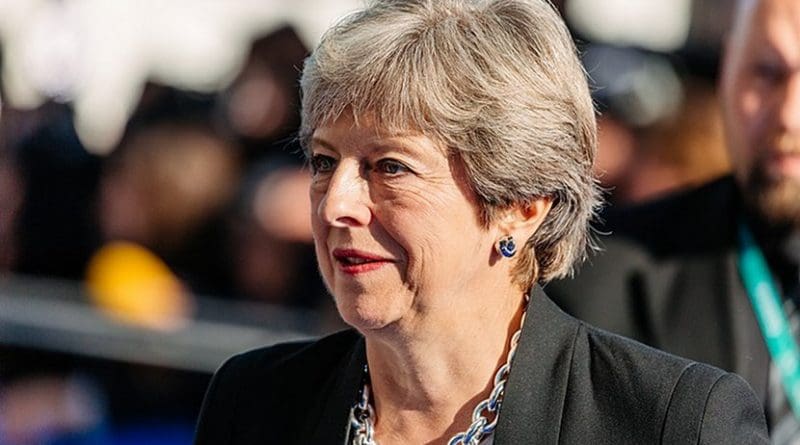Will Sick Men Of Europe Be Able To Weather Economic Storm? – OpEd
By Arab News
By Cornelia Meyer*
A whirlwind of events has engulfed Europe over the past six months.
While the effects have most been felt on its economies, these ripples
were inspired by politics. In fact, if the events of 2018 show one
thing, it is to what extent politics can undermine economic prosperity.
First there is Brexit, a self-inflicted saga. Prime Minister Theresa May
has “pushed” the vote on the Brexit deal to January 21, hardly enough
time for the European Union (EU) to get ready for it.
A hard Brexit is looking increasingly likely since May will probably not get the majority needed for a deal.
The International Monetary Fund estimates a six-percent decline in GDP
if a hard Brexit prevails, a stark comparison with projections of a
1.4-percent increase were the United Kingdom to stay in the EU.
The finance, automotive and chemicals industries would likely be the
hardest hit. Brexit will be a hard blow to small and medium-sized
enterprises (SMEs) because they lack the financial wherewithal to hire
the accountants and lawyers necessary to brace themselves for a no deal
scenario. And yet, SMEs currently hire 60 percent of the national
workforce, making them the most important segment of the labor market by
far.
In the shorter term, exporters fared well because they were aided by the falling pound, which was thanks, of course, to Brexit.
This will come to an abrupt end if Britain comes crashing out of the EU
under a no deal scenario. Both the exports and supply chain fronts will
be severely affected. The FTSE 250, which is composed of more
traditional British companies, is a good litmus test of what the Brexit
wobbles have done to the economy. It is down roughly 13 percent on the
year.
But it is not just the UK economy that is going to be hit by a hard
Brexit. Supply chains are inherently integrated within the automotive
and other manufacturing sectors, meaning importers will feel the pinch
once the free trade agreements come grinding to a halt, especially if
there is no transition period. The extent to which these chains are
affected is contingent on an orderly Brexit.
As if Brexit was not enough, there is Italy. The stand-off between the
European Commission and the Italian government over the budget deficit
may have been somewhat quelled with Italy’s latest proposal, which
brings down next year’s GDP deficit from 2.4 percent to 2.04. Yet it is
still too high to enable Italy to draw down on its overall debt, which
stands at 131 percent relative to GDP, well above the Eurozone’s 60
percent limit.
Only Greece beats Italy in this category. However, Italy matters much
more than Greece because it is the Eurozone’s third largest economy.
The Italian debacle is yet another man-made kerfuffle. Italy’s
government is composed of two populist parties, the left wing M5S and
the right-wing Lega. The budget is a compromise of sorts between their
two ideologies. While the former wants to guarantee minimum income and a
raft of other forms of social spending, the latter wants to reduce the
tax burden on the wealthy. While one side spends, the other limits the
fiscal income stream.
Meanwhile, in the Eurozone’s second largest economy, France, French
President Emmanuel Macron had to abandon the direly needed economic
reforms he initiated after violent protests paralyzed Paris and many
cities over several consecutive weekends.
While the riots were sparked by fuel tax, the issues run deeper. In
fact, far too many French feel economically disenfranchised and
politically powerless.
Those people cannot make ends meet. They also feel that they do not have
a seat at the table. This sense of disenfranchisement is by no means
limited to France. It permeates throughout Europe. The unrest led Macron
to abolish fuel tax, increase minimum wages and cut taxes in some
sectors, resulting in a projected budget deficit of 3.4 percent for next
year. Once again, this exceeds the three-percent limit allowed under
under Eurozone rules. The debt-to-GDP ratio stands at a whopping 97
percent and is set to grow further if things continue the way they are.
As though it is not enough that Europe’s second, third and fourth
largest economies are basking in such struggles, the EU’s largest
economy, Germany, has thrown a curve ball at the zone as well.
The German economy contracted in the third quarter of this year for the
first time since 2015, bringing the overall Eurozone growth rate down
from a projected 0.6 percent to 0.2 percent. Germany’s woes had a lot to
do with a fear of trade wars ensuing both between the US and China and
the US and Europe. Germany is the economic locomotive of the Eurozone.
Its automotive sector is the driver behind the manufacturing juggernaut.
US tariffs on imported cars would hit the economy badly, as will trade
wars with China.
Germany exports a lot of machinery to China and its Volkswagen and BMW
brands export a lot of their cars from their plants in the US to China.
Once again, the culprit is political forces in the US.
In short, economic storm clouds are fast gathering in Europe. That is
why the decision of the European Central Bank (ECB) to halt the $2.85
trillion stimulus program in December was a courageous move.
True, Mario Draghi, ECB president, left himself some wiggle room by
reserving the right to reinvest the proceeds of previous bond purchases
and leaving the interest rate unchanged. Only time will tell us whether
this can provide sufficient liquidity to help the economy weather these
largely self-inflicted storms.
- Cornelia Meyer is a business consultant, macro-economist and energy expert. Twitter: @MeyerResources

